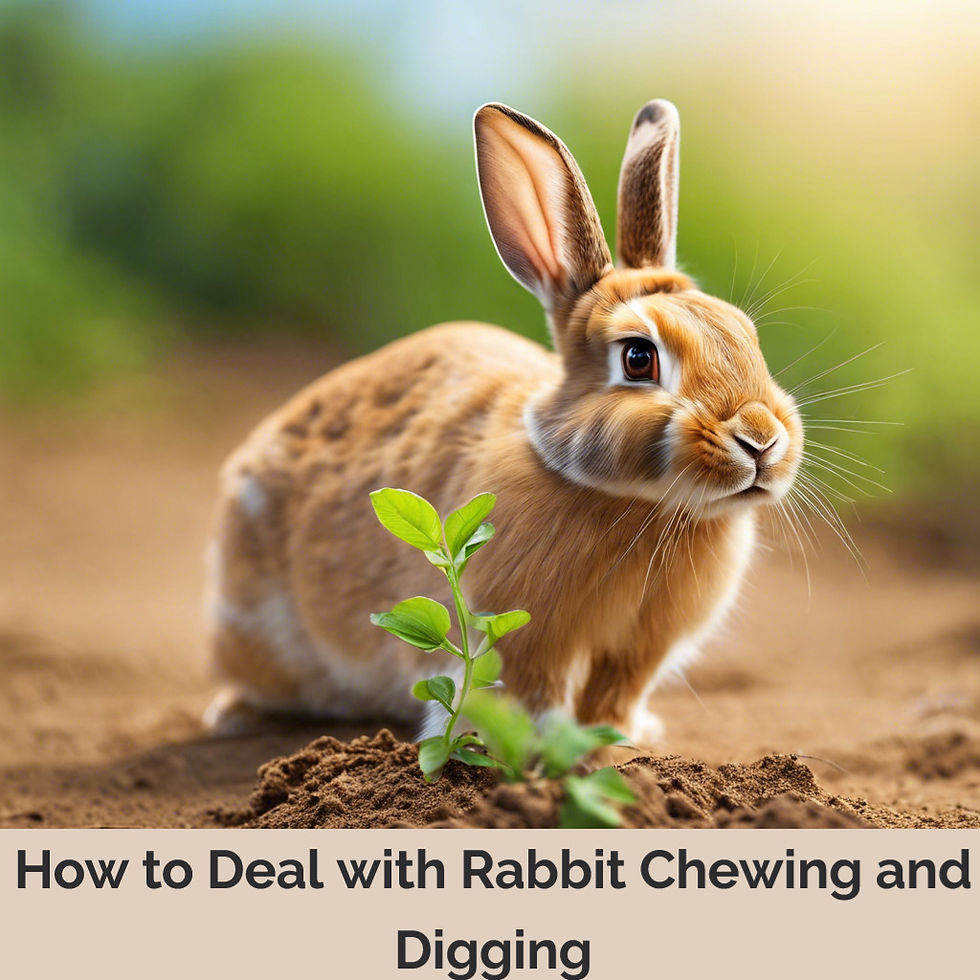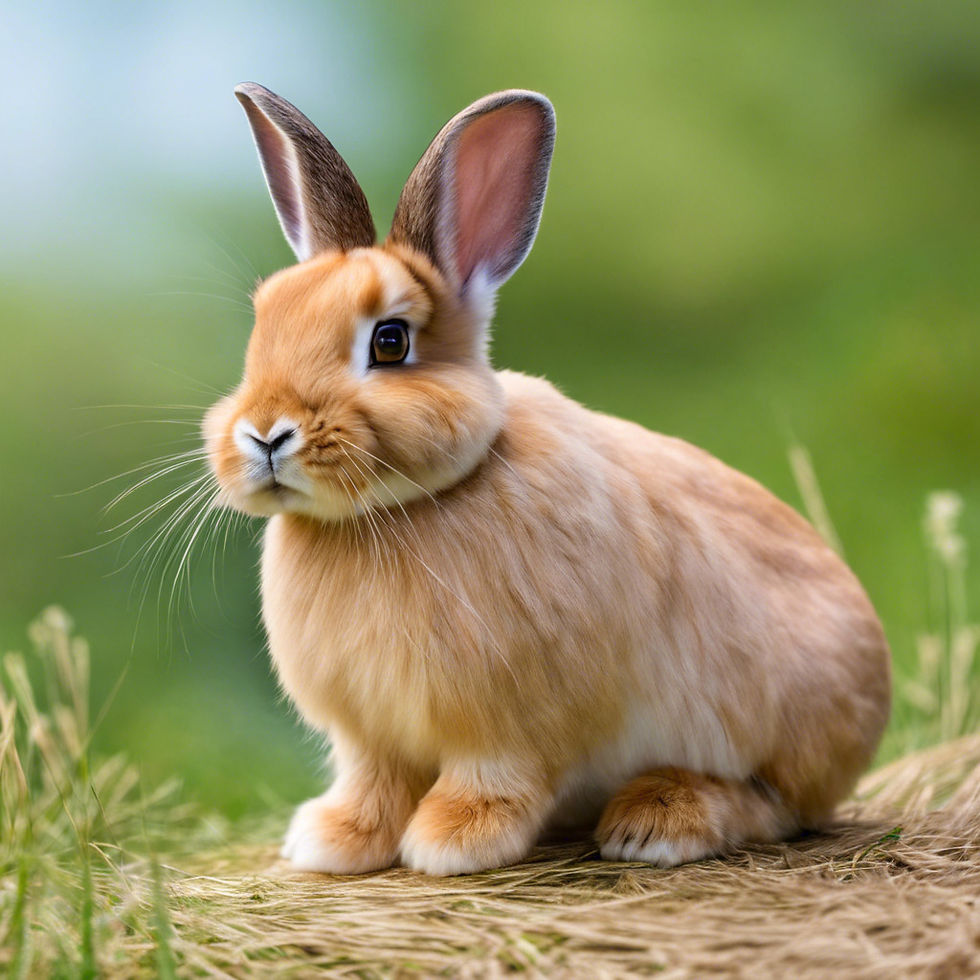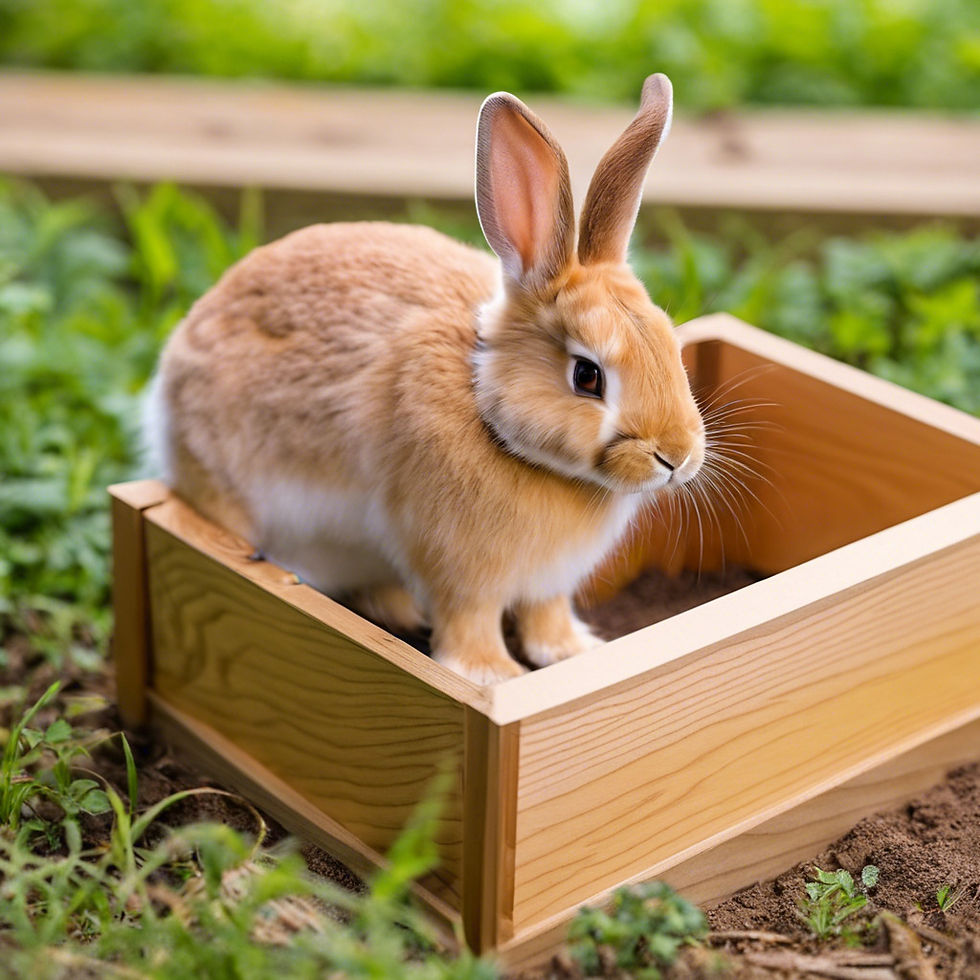When I first brought my rabbit, Hazel, home, I was enchanted by her playful hops, twitching nose, and boundless energy. But within days, I realized that owning a rabbit wasn’t all cuddles and cute moments.

Hazel had an insatiable urge to chew on everything—from my wooden furniture to electrical cords—and dig at carpets as though she were unearthing buried treasure. I quickly learned that chewing and digging are natural behaviors for rabbits, but that didn’t make them any less frustrating when I found yet another chewed corner of my sofa.
Dealing with a rabbit’s chewing and digging habits requires patience, understanding, and a willingness to adapt your home and routine. In this article, I’ll explore why rabbits chew and dig, share practical solutions, and offer personal insights from my journey with Hazel.
Why Do Rabbits Chew and Dig?
To address a rabbit’s chewing and digging, it’s important to understand why they do it. These behaviors aren’t a sign of mischief—they’re instinctual and essential to a rabbit’s physical and mental well-being.
1. Chewing is Essential for Dental Health
Rabbits’ teeth grow continuously throughout their lives. Chewing helps wear down their teeth and prevents painful dental issues like overgrown incisors or molar spurs.
2. Digging is an Instinctive Survival Behavior
In the wild, rabbits dig burrows for shelter, protection, and raising their young. Domestic rabbits retain this instinct and may dig to satisfy their natural urges or create a sense of security.
3. Stress or Boredom
Chewing and digging can also be signs of stress or boredom. A rabbit without enough mental and physical stimulation may turn to destructive habits to burn off energy or express frustration.
When Hazel started chewing on the legs of my dining table, I initially thought she was being naughty. But once I understood that her behavior was rooted in instinct and unmet needs, I was able to approach the problem with more compassion and effective solutions.

How to Deal with Rabbit Chewing
Rabbits will chew—it’s part of who they are. The key is to redirect their chewing behavior toward safe, acceptable outlets and protect your home from damage.
1. Provide Plenty of Chew Toys
Chew toys are essential for keeping your rabbit’s teeth healthy and satisfying their natural chewing instincts. Here are some great options:
Wooden Toys: Untreated applewood sticks, willow balls, and wooden blocks are safe and fun for rabbits to chew.
Cardboard: Simple, plain cardboard boxes or toilet paper rolls make excellent chew toys. Hazel loved shredding cardboard tunnels, and it kept her entertained for hours.
Hay-Based Toys: Toys made from compressed hay serve a dual purpose by encouraging chewing and adding fiber to their diet.
2. Rabbit-Proof Your Home
To prevent your rabbit from chewing on dangerous or valuable items, rabbit-proofing is a must.
Protect Cords: Cover electrical cords with plastic tubing or hide them out of reach.
Use Barriers: Block off access to furniture, baseboards, or areas where your rabbit tends to chew.
Remove Temptations: Store books, shoes, and other chewable items in closed cabinets or high shelves.
3. Offer Fresh Hay at All Times
Unlimited access to hay is not only essential for a rabbit’s diet but also provides a natural chewing outlet. Rabbits spend a significant amount of time grazing, which helps keep their teeth worn down and their minds occupied.
4. Use Positive Reinforcement
When Hazel chewed on her toys instead of the furniture, I made sure to reward her with praise or a small treat. Positive reinforcement encourages your rabbit to repeat the desired behavior.
5. Address Stress or Boredom
If your rabbit is chewing excessively, they may need more enrichment or social interaction. Spend time bonding with your rabbit, provide toys for mental stimulation, and ensure they have enough space to explore and exercise.
How to Deal with Rabbit Digging
While digging is harder to redirect than chewing, it’s still possible to manage this behavior in a way that keeps both your rabbit and your home happy.

1. Create a Digging Box
A digging box is one of the most effective ways to satisfy your rabbit’s digging instincts without sacrificing your carpet or furniture. To make a digging box:
Find a sturdy cardboard box or plastic storage container.
Fill it with rabbit-safe materials, such as shredded paper, straw, or hay.
Bury a few treats or toys in the box to make it more enticing.
Hazel adored her digging box. She spent hours happily burrowing and flinging shredded paper, which meant fewer attacks on my living room rug.
2. Protect Vulnerable Areas
If your rabbit is targeting specific spots, like a corner of the carpet, cover those areas with rugs, mats, or furniture until their behavior can be redirected.
3. Provide a Safe Outdoor Space
If you have access to a secure outdoor area, let your rabbit dig in the dirt under supervision. This gives them a natural outlet for their behavior and plenty of exercise.
4. Redirect Their Focus
When Hazel started digging at the carpet, I gently picked her up and placed her in her digging box. Over time, she learned to associate the box with digging and stopped targeting inappropriate areas.
5. Address Underlying Issues
Like chewing, excessive digging can indicate stress or boredom. Ensure your rabbit’s environment is enriched with toys, tunnels, and space to roam.
Why Punishment Doesn’t Work
One of the biggest mistakes I made early on was scolding Hazel when she chewed on furniture or dug at the carpet. I quickly learned that punishment doesn’t work with rabbits—it only makes them fearful or anxious.
Instead of punishing your rabbit, focus on understanding their needs and redirecting their behavior. Positive reinforcement, patience, and consistency are far more effective in shaping good habits.
Common Challenges and Solutions
1. My Rabbit Ignores Their Chew Toys
Rabbits can be picky, so it may take some trial and error to find the toys they love. Experiment with different materials, shapes, and textures. Hazel wasn’t interested in wooden blocks at first, but she loved willow balls and hay cubes.
You can also make toys more appealing by rubbing them with a sprig of parsley or sprinkling a few drops of apple juice on them.
2. My Rabbit Keeps Digging at the Carpet
If your rabbit won’t stop digging at the carpet, try placing a digging box in the same spot. Cover the area with a protective mat until they learn to use the box instead.
Hazel was obsessed with a particular corner of the room, so I set up her digging box nearby. By rewarding her every time she used the box, I gradually redirected her behavior.
3. My Rabbit Chews on Cords, Even When They’re Covered
Rabbits are persistent when it comes to chewing, and some will still target cords even if they’re covered.
Use sturdy cord protectors made of hard plastic or metal tubing.
Hide cords completely behind furniture or secure them out of reach.
If all else fails, block off access to areas with exposed cords using baby gates or playpens.
FAQs: How to Deal with Rabbit Chewing and Digging
1. Why do rabbits chew on furniture and cords even when they have chew toys?
It can be frustrating when your rabbit ignores their chew toys and goes straight for your furniture or electrical cords. Rabbits are naturally curious and love to explore their surroundings using their teeth. Often, furniture or cords are more enticing because of their texture, scent, or location.
When Hazel kept chewing on my table legs, I realized it wasn’t because she lacked chew toys—it was because she preferred the smooth texture of wood. I added untreated applewood sticks to her toy collection, and over time, she started choosing those over the furniture.
What you can do:
Rotate Toys: Rabbits get bored quickly, so switch out their toys every week to keep them interested.
Try Different Materials: Some rabbits prefer wood, while others like hay-based or cardboard toys. Experiment to see what your bunny enjoys most.
Rabbit-Proof High-Risk Areas: Cover cords with plastic tubing, and use furniture protectors to make chewing less rewarding.
2. My rabbit loves digging at the carpet. How can I stop this?
Digging is an instinctive behavior for rabbits, and they often target soft surfaces like carpets because they mimic soil. To stop your rabbit from ruining your rugs, you’ll need to redirect their digging behavior to something more appropriate.
What worked for me:When Hazel started digging up the corner of my living room rug, I placed a digging box nearby filled with shredded paper and hay. She loved burrowing through the box and eventually stopped going for the carpet.
Solutions to try:
Create a Digging Box: Fill a sturdy cardboard box or plastic container with rabbit-safe materials like shredded paper, straw, or fabric scraps.
Use Mats or Rugs: Protect targeted areas with durable mats or inexpensive rugs that your rabbit can dig at without damaging the flooring.
Redirect and Reward: Gently move your rabbit to the digging box whenever they target the carpet, and reward them when they use it.
3. Can digging and chewing be signs of stress or boredom?
Absolutely. Chewing and digging are natural behaviors, but if your rabbit is doing them excessively, it may indicate that they’re stressed, bored, or lacking enrichment. Rabbits are intelligent and social animals—they need mental and physical stimulation to stay happy.
Signs of boredom or stress:
Excessive chewing or digging in one area.
Thumping or hiding.
Aggression or irritability.
When Hazel’s chewing became more frequent, I realized she was bored because I hadn’t updated her toys or given her enough playtime. Introducing new toys and spending more time interacting with her made a noticeable difference.
How to help:
Add Toys: Provide a variety of toys to keep your rabbit entertained. Puzzle feeders, tunnels, and hay-based toys are great options.
Increase Exercise Time: Allow your rabbit at least 3–4 hours of supervised free-roaming daily to burn off energy.
Bonding Time: Spend quality time sitting near your rabbit or playing with them to meet their social needs.
4. Is it possible to completely stop a rabbit from chewing or digging?
No, it’s not realistic—or healthy—to expect a rabbit to stop chewing or digging entirely. These behaviors are natural instincts for rabbits and essential for their physical and mental well-being. The goal isn’t to eliminate these habits but to redirect them toward safe and acceptable outlets.
What worked for me:Hazel’s chewing and digging didn’t stop entirely, but by providing appropriate alternatives like chew toys and a digging box, I significantly reduced the damage to my home. I also learned to rabbit-proof high-risk areas, which made life easier for both of us.
Remember: Rabbits need to chew to keep their teeth healthy and dig to satisfy their instincts. Embrace these behaviors as part of their unique personality and focus on management rather than elimination.
5. My rabbit chews on baseboards and walls. What can I do?
Chewing on baseboards and walls is a common problem for rabbit owners. This behavior is usually due to a combination of curiosity and a lack of better options for chewing.
How to prevent baseboard chewing:
Protect the Area: Cover baseboards with plastic guards, furniture, or cardboard barriers. Double-sided tape can also discourage chewing in some cases.
Redirect Their Behavior: Place chew toys or hay-based items near the baseboards to draw their attention away.
Increase Supervision: If your rabbit is free-roaming, keep a close eye on them and redirect their behavior immediately if they start chewing.
In Hazel’s case, I added corner guards to protect the baseboards and made sure she had plenty of wooden chew sticks nearby. Over time, she lost interest in the baseboards and focused on her toys instead.
6. Should I punish my rabbit for chewing or digging inappropriately?
No, punishing a rabbit for chewing or digging is not effective and can harm your relationship with them. Rabbits don’t understand punishment the way humans or dogs might. Scolding or using negative reinforcement will likely make your rabbit fearful or stressed, which could worsen the behavior.
What to do instead:
Redirect Their Behavior: If you catch your rabbit chewing or digging inappropriately, gently move them to an appropriate outlet, like a chew toy or digging box.
Reinforce Positive Behavior: Reward your rabbit with a small treat or gentle praise when they use their toys or designated digging area.
Rabbit-Proof Your Home: Prevent access to areas where inappropriate behavior occurs to reduce frustration for both you and your rabbit.
When Hazel chewed on furniture or carpets, I avoided scolding her and instead redirected her to her toys or digging box. With time and positive reinforcement, she started to choose the right behaviors on her own.
Final Thoughts: Patience and Understanding Are Key
Living with a rabbit means embracing their quirks, and chewing and digging are just part of the package. While these behaviors can be frustrating, they’re also opportunities to bond with your bunny and better understand their needs.
For me, Hazel’s chewing and digging habits were a learning curve, but they also taught me patience and creativity. By providing the right outlets, like chew toys and a digging box, and taking steps to rabbit-proof my home, I was able to create an environment where we could both live happily.
If your rabbit’s chewing and digging are driving you crazy, take a deep breath and remember: they’re not being “bad”—they’re just being rabbits. With time, consistency, and a little effort, you’ll find solutions that work for both you and your furry friend. 🐰
Comments